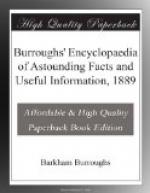Example. Multiply 7/8 by 5/6.
7/8 x 5/6 = 35/48. Ans.
TO DIVIDE FRACTIONS.
Multiply the dividend by the divisor inverted.
Example. Divide 7/8 by 5/6.
7/8 X 6/5 = 42/40. Reduced to simple form by dividing by 2 is 21/20 = [Transcriber’s Note: The original text reads ‘1^{1}’] 1-1/20. Ans.
TO MULTIPLY MIXED NUMBERS.
When two numbers are to be multiplied, one of which contains a fraction, first multiply the whole numbers together, then multiply the fraction by the other whole number, add the two results together for the correct answer.
Example. What cost 5-1/3 yards at 18c a yard?
18c
5-1/3
—–
18 x 5 = 90
18 x 1/3 = 6
—–
96c
When both numbers contain a fraction,
First, multiply the whole numbers together,
Second, multiply the, lower whole number by the upper fraction;
Third, multiply the upper whole number by the lower fraction;
Fourth, multiply the fractions together;
Fifth, add all the results for the correct answer.
Example. What cost 12-2/3 pounds of butter at 18-3/4c per pound?
18-3/4
12-2/3
-------
18 X 12 = 216
12 x 3/4 = 9
18 X 2/3 = 12
3/4 X 2/3 = 6/12 = 1/2
-------
$2.37-1/2
Common fractions may often be changed to decimals very readily, and the calculations thereby made much easier.
TO CHANGE COMMON FRACTIONS TO DECIMALS.
Annex one or more ciphers to the numerator and divide by the denominator.
Example. Change 3/4 to a decimal. Ans. .75.
We add two ciphers to the 3, making it 300, and divide by 4, which gives us.75. In the same way 1/2 =.5, or 3/4 =.75, and so on. When a quantity is in dollars and fractions of a dollar, the fractions should always be thus reduced to cents and mills.
* * * * *
TWENTY THOUSAND THINGS WORTH KNOWING.
RELATIVE HARDNESS OF WOODS.
Taking shell bark hickory as the highest standard of our forest trees, and calling that 100, other trees will compare with it for hardness as follows:
Shell Bark Hickory 100 Pignut Hickory 96 White Oak 84 White Ash 77 Dogwood 75 Scrub Oak 73 White Hazel 72 Apple Tree 70 Red Oak 69 White Beech 65 Black Walnut 65 Black Birch 62 Yellow Oak 60 Hard Maple 56 White Elm 58 Red Cedar 56 Wild Cherry 55 Yellow Pine 54 [Transcriber’s Note: The original text reads ‘Chesnut’] Chestnut 52 Yellow Poplar 51 [Transcriber’s Note: The original text reads ‘Buternut’] Butternut 43 White Birch 43 White Pine 30
Timber intended for posts is rendered almost proof against rot by thorough seasoning, charring and immersion in hot coal tar.




